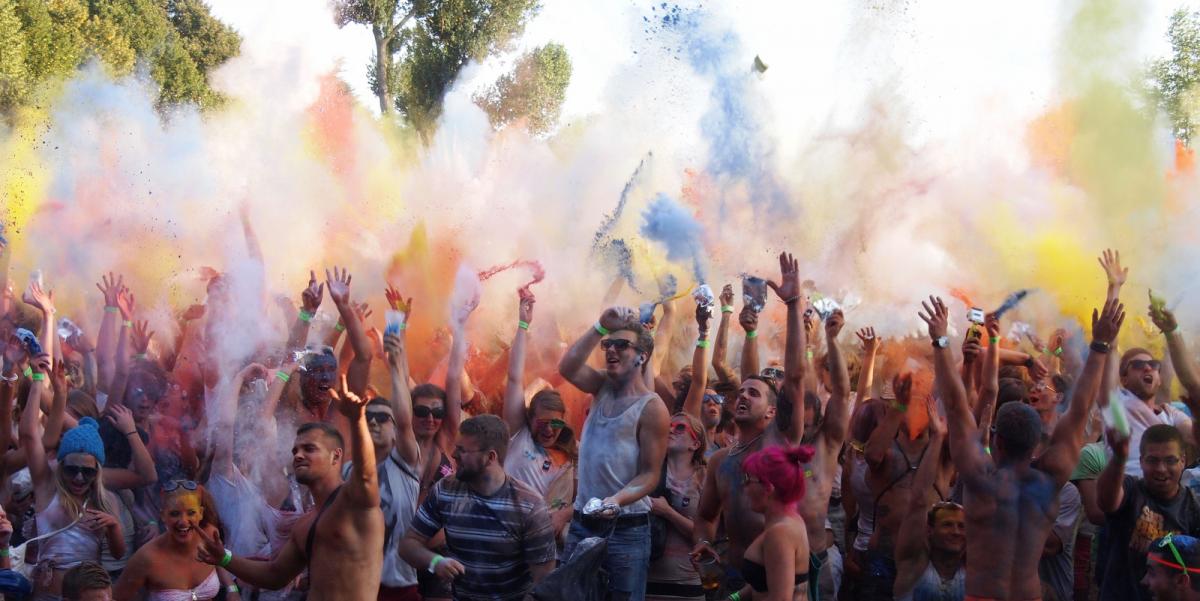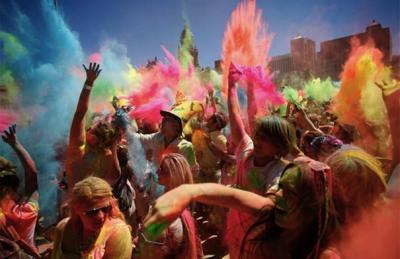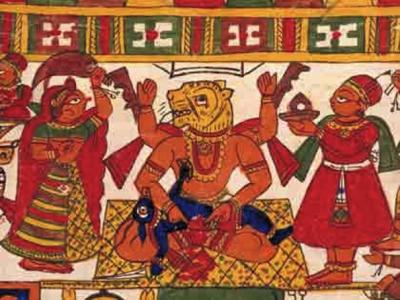The Hindu religious festival Holi has recently become popular in Europe and in South Africa. One example is the huge open-air «We are one» in Johannesburg: With a line-up of South Africa's biggest DJs, thousands of people dressed in white dance, drink and throw coloured powder around. However, self-labelled as «multi cultural», this party hasn't anything to do with adopted traditions or diaspora-culture, but with selling escapism to privileged white youths. The first version of this text was published last week on Africa is a country and triggered heated debates. As reaction to the comments, Neelika Jayawardane rethought the topic for Norient.
March marks the springtime festival of fertility and harvest, Holi, which is celebrated throughout northern India. Because Holi is a yearly event that includes a large amount of revelry, without the obvious presence of the sacred, it’s become adapted by some odd pockets of people. I even saw a «Festival of Colours Run» race recently: you run a 5K and get bombed by coloured powder (immediately after that, I found blogpost titled, THE COLOR RUN IS THE MOST CULTURAL APPROPRIATIVE SHIT I’VE EVER SEEN on the Blog «India is Not a Prop Bag»). What a pity that the organisers and participants of various «Holi Fests» in South Africa didn’t get that memo. Even calling it «Holi fest» irritates a little – as if it is now commoditised nicely into yet another neo-hippy-wellington-meets-muddyshit-and-rapedrugs-in-drinks music festival.
There were Holi Fests in Cape Town and Durban (both equally silly), but the Jozi leg left us at AIAC wondering if the stars of «Jersey Shore» were sent on a cheap version of Spring Break with some ground up chalk dust. Someone has already taken down the video, which was playing freely on Youtube last week – most likely, a featured performer was embarrassed enough that she/he asked to have it taken down – but not before Dylan Valley, Sean Jacobs, Tom Devriend, and I got to see it before shyness suddenly descended on the featured players. The video featured young South Africans (overwhelmingly white) being predictably drunk, embarrassing themselves at the Johannesburg Holi «We Are One» Festival. It basically looks like «a piss up where people throw coloured powder at each other,» said Dylan, by way of introduction. Indeed, the video featured (again, yes, mostly those of largely European descent) people plastered in what appears to be very cheap pastel powders, mouthing such gems as (which we jotted down before the video was pulled):
«I actually went to the real Holi fest in India and I have to say this is much better»; «I hope I don't turn Indian» and: «Get super colourful and get pictures and get DRUNK! Fuck girls sideways!»; «YOLO!». Then this dude: «There's plenty bitches but they all look the same because they're all so colourful.»
Three black guys also make their debut – so it is diverse like a «rainbow» we suppose. There's that awkward moment that one dude gets what he's doing: «besides the really fucking terrible music, and exploiting someone’s else’s sacred festival…I get to get drunk with my friends for a massive fee.» Later he says, «Everything that’s wrong about the world is perfectly and succinctly and sophisticatedly expressed here today» and «all this really is a bunch of privileged white kids with shoes and nice clothes walking around and pretending we know anything about any other culture.» It’s true that he says these things when prompted by the makers of the video, but it’s difficult to know how an intelligent person like this man can create a small space of amnesia in order to participate in the very things he critiques.
Its one redeeming quality: Dylan said, «At least the makers of the video seemed to intend to show it up for the farce that it » And I have to agree, though they don’t seem to know much about the mythologies surrounding Holi, why it is a significant moment of revelry and merrymaking, or about the music they picked as the soundtrack. The song played at the opening of the video is an invocation to Lord Shiva: «Satyam Shivam Sundaram» (Truth is Eternal and Beautiful; «shivam» can refer directly to Shiva, or to the idea of the eternal. The songstress is Lata Mangeshkar, who is as beloved and famously mythologised as any goddess, singing in a style that truly does invoke the sacred. Here's the original, created for a movie directed by Raj Kapoor (1978).
Video not available anymore.
The film about a vain man who can't see past the skin-deep beauty for which he hankers, and learns to see past his earthly obsessions and find love and beauty in a deeply scarred human being only when his earthly projects are destroyed. The opening scenes in the music video will tell you that despite some pervasively repressive sexual notions, Indians are no prudes: the fire-damaged heroine is lovingly «bathing» a lingum (a stone phallus that symbolises Shiva’s virility) set on a yoni (the goddess Shakti, who symbolises the strength of female creative energy), invoking the arrival of love and fecundity into her life.
In our first viewings of the Youtube video of Jozi’s Holi Fest, some neo-Punjabi dance music is cued in after Lata Mangeshkar sings her invocation to Shiva. That’s also somewhat accidentally appropriate, because bhangra is traditionally played at revelries following harvest, though morons shouting «bitches are so colourful» are a rarity at such moments of celebrations.
In Cape Town, things went down like this officially, and like this in reality. And Durban’s version boasted free entrance to the beach (glaringly obvious that the festival of Holi should never require an «entrance» fee…since… well, like one of Dylan Valley’s friends said: its like getting people to pay to fast for Ramadan. Apparently, no liquor was involved, but «herb», however, may have made a strong appearance. The presence of marijuana wouldn’t be a serious problem in any case – or somehow make Holi ‘inauthentic’: some in northern India drink a heady mix of sweet, full-cream milk and ground up marijuana buds to really experience a trance-like state. In India, too, there are millions who are not Hindu – people who come from long traditions of Islam, Christianity and Sikhism – who celebrate together with their Hindu neighbours, throwing coloured powder on each other while wearing old clothes when Holi rolls around in the springtime.
Subversion and Escape
Mikhail Bakhtin, the Russian critic, described «carnival» as a literary mode evident in Medieval and Renaissance works. Using humour, subversion of hierarchies and chaos to disrupt dominant modes of structuring society, carnival frees – if only for a moment – those who are beholden to those structures. He stressed that carnival was distinct from any official or sanctioned ceremonies, providing a different space than did theatrical performances. Whereas theatre, at least that which follows western conventions, is based on creating distinctions between spectators and actors, in carnival, all are participants, experiencing a sort of «second-life» or alternate, upside-down moment in which all may, without impunity, temporarily suspend social hierarchies. Here, the actor is the spectator, and vice versa; master may be servant, the bishop a layperson, and the maid could don a man’s clothing and harass the master with the same level of disdain that power makes available in intimate zones. Such festivities provided a practical release for repressed and regimented societies, but they also had spiritual and ideological functions. Laughter, the most important part of revelry in carnival, could be directed towards anyone without impunity, and with multiplicitous meaning: happy and inclusive at one moment; mocking and disparaging in another. Thus, the grotesque is intrinsic to carnival: while there are elements of ideal and utopian in such moments of abandon and revelry, they are also open to the possibility of alienation and hostility.
What we’re objecting to people tapping into another culture’s way of experiencing carnivalesque escape. The whole reason festivals and carnivals exist is so that we can forget distinctions of caste and creed – upend hierarchies, as Bakhtin wrote. Carnival is meant to – temporarily, at least – give us that opportunity to peek into a life in which we can live as one. And hopefully, that glimpse will prompt some lifelong transformations. I’m almost sure no such thing happened here.
Like the infamous Jersey Shorites, who frequent the boardwalks of the US’ Eastern Seaboard every summer – to score deep orange tans, attempt to ‘DJ’, throw up while riding bikes completely smashed, proudly display their douchebag abs for the camera at a moment’s notice, dance with the occasional hotel lobby plant, and then put it all on television – anyone can see that these kids in the Johannesburg «fest» are posers doing their best to do the dance of youthful bravado. Their nod to carnivalesque hedonism – however tame – is no different from that of tens of thousands of others around the world who are privileged enough to be able to indulge themselves in such expensive escapism. And in any case, one can't stop assholes from putting a statue of a «fat Buddha» in a bar, any more than one can stop these desecrators, who are busily – and completely unawares – are agreeing to the commodification of their own youthful lives: that’s hardly revelry and rebel-ry. We get what the post-racials are looking for: to be «colourful». Without the trouble that comes with being Colourful. Sadly, rather than upending social conventions, and questioning hierarchies, this slew of commercial Holi fests simply re-inscribe and reinforce them.
How to Deal with this Observation?
When I wrote this post for Africa’s a Country, we, as a team, expected a lot of pushback on this one – one doesn’t critique the privileged practices of people who are used to ownership (of others, their practices, etc.) without meeting their ire. Most were angry that I’d referred to Bakhtin – this made the post open to criticism centred around half-formulated rants about its «pseudo-intellectualism» and «self-importance». To them, all I could say was, «You may want to revisit critical theory, so that you get it, without me having to spoon feed you.»
Others felt that people all over the world have adopted the bright lights of Christmas, and the chocolate bunnies of Easter, so what’s the harm in «us» adopting traditions from «others»? First, I have to say that the chocolate bunny and eggs business hasn’t caught on in the Indian subcontinent, though the commercialisation of Christmas (which has spread to nearly every corner of the globe), is something common. This is largely owing to the fact that Christianity, and the attendant commercialisation of Christmas, is part of the hegemonic culture of the geopolitical west. Christmas arrived with blue jeans, missionaries, and neo-liberal policies: it’s just a part of how a powerful, hegemonic culture enters the everyday practices of far-away places. However, when powerful cultures appropriate, they do so in order to post their stamp on it – and this practice of taking ownership of the other’s symbols, stamping it as one’s own, and erasing any trace of the Other is already evident in Christianity. Many of us might already know this: the bunny and eggs during springtime, and the fir-tree decorations and lights at winter were Pagan rituals; Christians, who swept into northern Europe (often killing Pagans and forcing their beliefs out), appropriated their practices, and made them «Christian».
Video not available anymore.
However, other people who went to the festival also wrote us. Alexandra Searle wrote that she was «so excited to be able to show my 18 year old brother some fragment of India»; she even made him miss some classes at his university for this festival. They went, expecting «a multi cultural event, drawing liberals and leftys, old and young, [hoping for] authentic food and explanations of the festival, and some grounding in the India version of Holi.» But it turned out to be «a mortifying experience». The only multi cultural dynamic was bought – tragically and seemingly unnoticed – by the cleaners, who desperately scrambled between, around and through drunk, disrespectful and inappropriate white youth – trying to pick up the empty used packets from the «paint/powder/chalk»…. These cleaners where pushed, cajoled, heckled and of course not assisted in any way in their job (despite the large numbers of maxi sized plastic bins around the circumference of the paint area)…
My partner toyed with the idea of taking a picture of this «multi cultural» (cleaners) dyamic and posting it where ever we could – with a bit of commentary about the festival… but in the end – he was unsure how it would be received in this «new» South Africa, and decided against it.
We poured out «paint/powder/chalk» and left rather rapidly…. We were the only people walking out, against a sea of white (also dressed) intoxicated youth swarming in to «celebrate Holi»!
«I have some beautiful pictures…and perhaps one day I can show Francis (my 18 year old) Holi in India… because – this was certainly not it.»
Others, too, like Indira, wrote to say that though she agreed with our observations, she thought that «the substance of the critique will probably bounce off the people who pay money to indulge in this ‹revelry›»…[this] is no different from all the other festivals we’ve gone to or continue to go to in [South Africa] that promote: peace, love, unity, respect for each other and the earth but turn out to be large white dominated carbon footprints filled with beer bottles, vomit and misogyny. Personally, I can’t stand the sight of another nature reserve littered with trash after a weekend festival supposedly promoting the above values. This festival is just another excuse to make money, another commodification, as the writer describes it. There are still rules and regulations, still hierarchies.»
To Conclude: the Complex Holi-Story
Yes, cultures are shifting things, so the practices surrounding Holi has undoubtedly changed over time – so this isn’t about saying that you must have some sort of «authentic» pass to practice my ancient, pure tradition. But when people «use» without context or understanding, without even an inkling of respect, they’re usually performing that special kind of willful ignorance intrinsic to believing that all shit is there for them to take – and this video is a particularly gross piece of evidence displaying South Africa’s own brand of crass privilege.
An apt American proverb may say it best here: you can put lipstick on a pig, but that don’t make it Marylin Monroe. Likewise, throwing some coloured powder, shouting «bitches» at every other sentence, and having only the desire to get wasted is not going to make this mess Holi. Holi has its origins in a couple of myths that, like many legends and fairytales, are not altogether savoury. It is generally seen as the celebration of the victory of good over evil, but much of the content of these legends favours the triumphant arrival of a new pantheon of Hindu gods over the ‘demonic’ creatures that were part of the belief system of the subcontinent’s indigenous people. The roots of one myth involve the story of «demon» king Hiranyakashyap, who, with the help of his demon sister, Holika, wished to end the life of his son, Prahlad. Prahlad, despite his father’s demonic and arrogant nature, was a faithful devotee of the god Vishnu: this terrified his powerful father, who believed himself to be the ruler of the universe, and thus, above all the gods. Holika, the sister, was enlisted to destroy the holy Prahlad. She had the magical power of immunity to fire granted her by the gods, so she leapt into a fire, and held Prahlad in middle of the conflageration. But no harm occurred to Prahlad; instead, Holika burnt in the fire: one must never use a gift from the gods for evil purposes.
Then, there's also the story of Radha and Krishan, which is closely linked with the tradition of throwing coloured powders during Holi. Young Krishna, who had a dark complexion (he usually painted a beautiful turquoise blue), was supposedly jealous of his beloved consort Radha's extremely fair skin. One day, he playfully applied colour on Radha's face. This story still prompts young lovers to paint their beloved’s faces as an expression of love – at least on the Bollywood screen. This legend clearly reveals the subcontinent's anxieties about our dark skinned ancestors – so there's much to find problematic here. But part of what I like is the negotiation with self-loathing that Krishna must go through – it is an admission of his fears and envy, revealing a process of wrestling with a positioning that neither he nor Radha can control. At some point (not necessarily at the conclusion to his self-leathing), he decides to paint his love with colour, and in that action, sees his own colour as something desirable.
See more Photos here and here.










